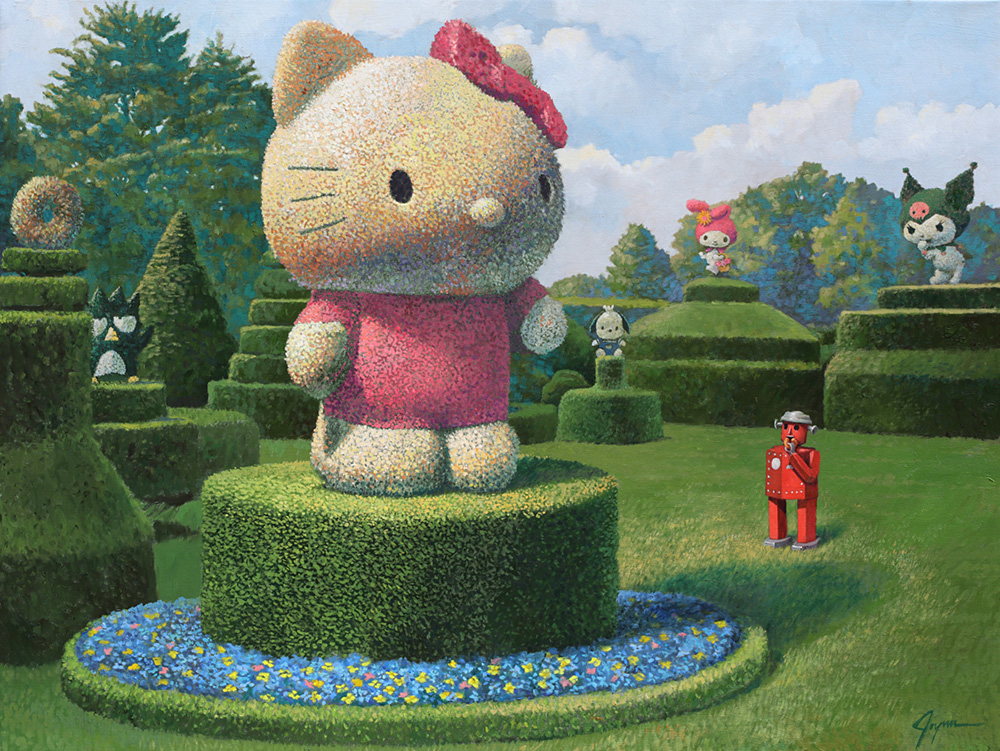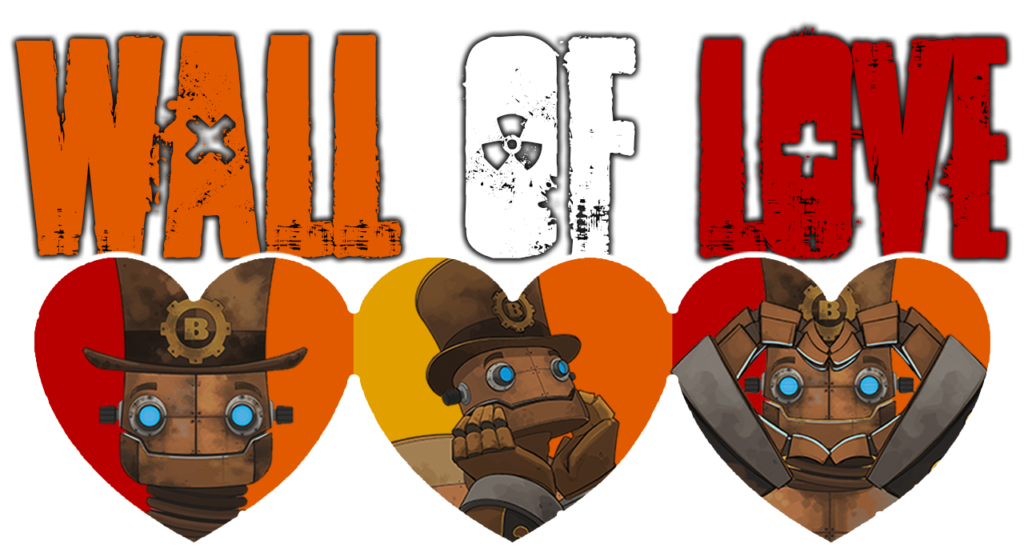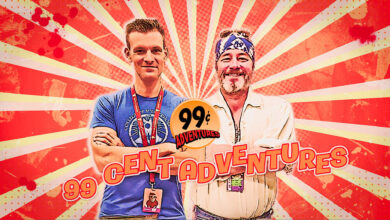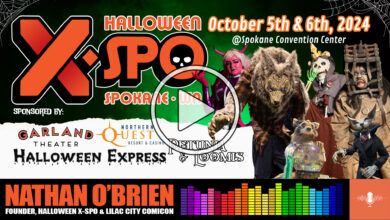Eric Joyner: Robots & Donuts Master of Pop Surrealism, Tin Toys, and Sweet Treats
Robots & Donuts Creator, Eric Joyner is captivating worldwide celebrities and audiences with his delicious artwork.
ERIC: “I would say 2,500 probably over the past 25 years. That sounds about right. You gotta remember this includes partial robots. It means just a head or an arm or a leg. Entire robots? Like the full figure? I would say maybe 1,500.”
ERIC JOYNER, CREATOR OF ROBOTS AND DONUTS

arth survivors. We’re bringing you tales from today’s guest, Eric Joyner, the legendary pop surrealist artist known for making robots dance on canvas with donuts as their truest nemesis. He is an American painter working in oils whose paintings have been featured in numerous TV shows, films, and advertising. He has been hired to paint Hello Kitty for Sanrio and robots for Dunkin Donuts. Eric sees the often absurd nature of life, and just tries to entertain himself and others with humorously composed paintings.
Let’s explore Eric Joyner’s canvas world of tin toys and giant pastries!
Eric: Thank you, BOOM.
Eric: This is a very difficult question to answer. I’ve wondered myself quite a few times. I would say 2,500 probably over the past 25 years. That sounds about right. You gotta remember this includes partial robots. It means just a head or an arm or a leg. Entire robots? Like the full figure? I would say maybe 1,500.









Eric: In the late 1990s, I decided to become a gallery artist or a fine artist, but I didn’t know what to paint. So, I looked around me and I saw some old tin toys on a shelf that I’d been collecting since art school days. And I thought, “Well, I’ll paint those. I’ll put them in strange settings and see how that goes.” So I did this for about four years. But after that, about 2003, I got very bored with it and I was at a dead end. I didn’t know what to do. As fate should have it, I was watching a movie called “Pleasantville,” and it starts out in black and white. And there’s a scene where Jeff Daniels paints the still life of donuts in black and white. But as he does, the whole movie becomes colorized. So that’s when I had the epiphany. And the next morning, I started to work on robots and donuts.

Eric: Yes, my work has been featured in a few other shows, such as Disney’s “Zeke and Luther”, “Zoey 101“, “Young Sheldon” on Warner Bros. There’s a couple of shows that I got licensing fees only, I think the artwork may be there, but I haven’t watched the shows, so I can’t really guarantee my work is in them. And that would be “Silicon Valley” on HBO, and “This Is Us“, I believe that was NBC. Later on, I got a script in the mail from out of the blue for a movie. It was called “Group Sex”. Then I got a call from this guy, Greg Grunberg. He said, “Eric, I finally figured out a way to put your work in a movie.” I thought, “Oh, really?” And so I said, “I’ll think about it.” And I read the script, and it was a romcom, which was a rather wacky romcom about love, unrequited love, and addiction, and I was able to get a cameo out of it, and that was very interesting. I realized I don’t want to be an actor. It’s very long, long hours, and hard work, and a lot of personalities you may not like, and people standing around. I don’t know. I prefer the solitary life. This movie, “Group Sex”, anyway… It had Tom Arnold in it, as well as Henry Winkler, Gregg German, Kurt Fuller, Lisa Lampenelli. Check it out!

Eric: The way I did it was by having a website full of robots and donut artwork. Worked like a charm! One day, I got an email from a guy who said he had a humor blog, and he suggested that I do a boxing painting, and send me the pictures of the painting in progress, and he would post them on his humor blog called “The Sneeze”. And I said, “Well, sure, I have nothing to lose.” I might as well just do it, you know, I was pretty much broke at the time, so I did it, and I kept sending them. And apparently this website had 100,000 visits per month. So that was a big deal back in 2003. At the end of the project, it was late December. I needed some money real bad. So, I said, “Hey, why don’t you buy this off me?” And he goes, “Sure.” So he bought it for a $1,000. In the meantime, I had actually sent a slide of this painting called, “The Final Blow” to a very prestigious art contest, worldwide art contest called “Spectrum Fantastic Art”. They have an invitation thing, and they ask people from all over the planet to enter the contest. Eight months go by, and I get an email from a guy in Texas. He said, “Congratulations on getting your artwork on the cover.” And I thought, “What?” I promptly fell out of my chair and went and bought a Juxtapoz Magazine. And sure enough, there was an ad for it with my painting promoting the book in Juxtapoz. So that was, like, really great. And a funny thing happened. Years later, Steve got a job writing for this show called “The Big Bang Theory”. And the first day on the set, he walked in and there’s the painting. Actually, it was a print of my painting in the set, the main set. And so he was so excited, and he called me up. That’s because the set dresser went to my art gallery and bought my book, and she was flipping through it and contacted me, and asked if I could put my work in their show. And I said, “Sure.” One thing leads to another, and I started getting stuff on Disney. Let’s see NBC, then some movie projects. It was a lot of fun. Anyways, the key is to have an internet website and have some notoriety and use social media. And the word goes like wildfire around the world. Before you know it, you’re very busy.
Eric: I started attending conventions… I believe it was 2004. So that makes it 20 years I’ve been going to conventions. First being Wondercon. I snuck in with my portfolio and threw my stuff on somebody else’s table, an artist that never showed up. And it was a huge smash hit. So I had a great time and signed up officially the following year in San Francisco, and that was a very successful show, too. So, I did that two or three years, and unfortunately, Wondercon decided to relocate to Anaheim, California. So I stopped doing it. About that time, though, I started showing in San Jose at the San Jose Super Toy Show, which was a lot of fun. And that continued for several years, at which point I met Lou Lima, who offered to share his table at San Diego’s International Comic Book Convention. It was a small press table that was very crowded and interesting show. It was so crowded, we decided to buy a booth for the next year. And we continued to buy booths every year up until this year, which will be my last show, San Diego’s Comic Con, and I’m going to start showing in Las Vegas instead at the DesignerCon, as I have some different things I need to show the world.
Eric: Yes. I have two helpers, Lou Lima and Chris Compton. They’re really great. They designed the booth and set it up, and I would not be able to do these things without them. Every year, it’s been the same reliable two guys that get me through this Comic Con Convention. I could sure use a robot like you though, BOOM, to take my place and meet people. It is really emotionally draining to meet so many people, and I’m sure you’d be way better at it than me.
Eric: Great question! Yes, I met people that I’d heard about or seen on TV, such as Tool guitarist, Adam Jones, “Simpsons” creator Matt Groening, “Big Bang Theory” actors Jim Parsons, Johnny Galecki, Simon Helberg, “Mythbusters” creator and host, Adam Savage, animation director for Disney, Steven Sandoval. They were all fantastic people. Adam Savage would have these really great parties on the 11th floor of the Marriott overlooking the bay. All these really interesting guests and fireworks would go off, and all kinds of interesting conversations were held there. On the flip side of the coin, there were times I’d rather not relive, such as nearly getting my eye gouged out, setting up the booth, and having to go to emergency, getting antibiotics, and enduring the convention with this bright red eyeball. Oddly enough, I had two other eye infections on separate years. I started to think my eyes were cursed or something. But luckily, you know, the last couple of years, nothing bad happened to my eyes. So, maybe it was just a coincidence. There was the time when I drove home, I was totally exhausted. I decided not to stay an extra Sunday night in San Diego, so I made a wrong turn and ended up in Fresno. It took me 16 hours to get home. It was really grueling, and I was not a very happy camper. So I tend to remember vacations or trips when something bad happens, and that was definitely one of them.





















Eric: I tend to get influenced greatly by movies, and history, and nature, space. And in any particular year, I might be more focused on certain environments than others. Also talking to people, and just whatever situation is, or whatever the setting is, it has to meet certain criteria in terms of beauty, composition, and possibilities. I tend to like to make artwork that people would like to hang on their walls. You know, you think about mood. You know, they want to calm people down or laugh or relax, I guess trying to get an emotional hook in my artwork. And I tend to have sleepless nights. I’ll sleep a little and then wake up. I’ll think about this very problem. And when you’re in a quasi sleep state, things seem good to you, and then you fall asleep. And if you still remember it, when you wake up in the morning, it’s probably a good sign that it’s a good idea. So you should go with it.
Eric: Humor contributes quite a lot. I think it’s a great vehicle for artwork, and I highly recommend it to any budding artists to at least give it a chance. Works in all art forms. But honestly, my favorite paintings are the ones that evoke several emotions in one painting.
Eric: I went to art school, and I was exposed to N.C. Wyeth and J.C. Leyendecker, and for some reason, to this day, those two guys have influenced me the most. After that, you have the usual suspects, such as van Gogh, Degas, Rembrandt, Monet, and some of the other post-impressionists, I really like. But I also like the storytelling quality that Norman Rockwell had, and I liked his consistency. I liked the drama of Frank Frazetta and Jeffrey Jones, and I like the genius of Syd Mead. So there’s quite a few artists and it’s really hard to put it all together, come up with a new style. So, I guess what you have to do is take it all in and then forget about it, and hopefully through many years of practice, you’ll come up with your own style.
Eric: After I have my idea nailed down, I will start doing sketches and also a little bit of photography or observational work that I need to do. Also research, on settings and inspiration. I will take all these and imaginary sketches into Photoshop and rearrange them to get a good, nice composition, which is very important in artwork. And then I transfer the whole thing onto a canvas or a wood panel, and begin a very traditional method of painting in oils. I fix the drawing with fixative, work from background to foreground, dark to light.


Eric: My experience creating art books was not too difficult, when you’re working with experienced editors like I had at Dark Horse Publishing. The most difficult thing is to have the artwork A, and B throughout the years, keep photographing your work at the highest quality so that they reproduce well. After that, you got to think about all the interesting notes you can add to the book. Me personally, I don’t like art books with a lot of text. I like to see the artwork, so that’s the way my books turned out. They will send you a PDF of the mock-up of the whole book, and then you can ask for changes. It’s as simple as that. Well, you have to negotiate a contract, too. That’s up to you.

Eric: This question comes up quite a bit, and frankly, I have never licensed any character. In the Hello Kitty situation, I was asked by them to do it for a big art show honoring their 40th anniversary party. All the other robots I have, a lot of the companies, they’re all defunct. There’s something in law called fair use and satire where you can use something to a limited extent. And also, I changed the robots quite a bit, so they’re no longer the same robot. On top of that, I think you have to make a million dollars on something before anybody wants to sue you. So I’m really not concerned.
Eric: I would have to say my favorite robot to paint is the typical blockheaded one. It’s just something funny about a blockheaded robot. It’s funny though, I end up always making the limbs a little bit longer, and make them more flexible because they’re not very expressive, and I like to express some emotion with my robots.
Eric: I recommend that a robot take a deep breath, stand up, walk away from the computer, walk around the block if he has to, eat a box of donuts. But don’t go crazy. Relax, and calmly write your congressman. Express your complaints.



Eric: Over the years, I’ve printed on cups and calendars, and had books published. But I’d have to say the most popular thing I’ve done was limited edition prints. I have print runs going for every single one of my paintings. There must be like 500 paintings, and they’re on the website. It keeps me busy. It breaks up the monotony. You know, who wants to paint 24 hours a day? You know, you want to do something different, enables me to do something in a different part of my brain, I should say. This print thing is going to be eclipsed by my new sculpture that’s coming out in the fall of 2024 called “Snake Fight“. It’s an eight and a half inch tall sculpture of a robot wrestling with a snake, and he’s trying to keep his donut away from the snake. Painting is based on a picture I did back in 2011 called “All Wrapped Up“. So, I’m really looking forward to showing these at the DesignerCon in Las Vegas this fall. Look into that? Maybe come meet me there.
Eric: Yes, I am collaborating on a project with a man named George Gaspar. He’s part of a company called The Four Horsemen, and they’re based out of New Jersey. He is a 3D modeler, and toy enthusiast, and expert artist sculptor, and he’s been around for many years, and he’s really great, so he’s going to be taking control of the project of “Snake Fight”, which is the robot fighting the snake. He has a factory that he works with in China that will be doing a lot of the work as well, and he’s going to be doing a lot of 3D modeling and the whole project should be delivered in about six months. So, come see me in Las Vegas. I’ll have a booth at DesignerCon, and ask me any questions about it, and have a very close look. You can even order one.
Eric: It’s really difficult to predict the future, but I hope, certainly hope that my work will be in more prestigious collections, perhaps even some museums. That would be nice. One thing that does kind of interest me though, is all that’s going on with rocketry and spacecraft advancement and all the different companies that are willing to make explorations onto different planets and the moon, and also the new telescopes that are going up. I think that might lead to more space paintings.
Eric: I’d like to give a heartfelt thanks to all the people who have bought prints, paintings, and books over the years, as well as all followers in social media. These people, 99% of which I’ve never met and probably never will, have given me direction and helped shape the work that I do. I’d like to thank the Corey Helford Gallery in Los Angeles who I’ve been exhibiting with for the past 20 years. And finally, I’d like to thank Trancefusion Design for the creation and maintenance of my website. Thank you all very, very much.
Eric: Facebook as well as Instagram. I have a X account, but I never really read it. My website, ericjoyner.com, has all the links at the bottom. Instagram is just @ericjoynerart. My Facebook handle, I believe, is facebook.com/robotsanddonuts. But the best thing to do is just click the link at the bottom of the front page of my website. Thanks.
Eric: I hope to make the world a better place by raising people’s spirits during these dark times, and to not give up. Also to inspire creativity, especially amongst the young.
Eric: Thank you, BOOM. It’s been a pleasure. Thanks for having me jog my memory and consider the deeper aspects of what I’m doing. I look forward to meeting you someday.
Discover Eric at https://ericjoyner.com or find him on:

Did you know that you can record a video or type a comment for this POPcast transmission?
BOOM’s Transmissions, a post-aPOPalyptic POPcast brought to you by BOOM Rattle BOOM LLC.





